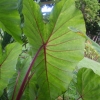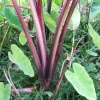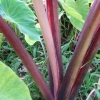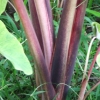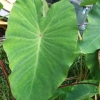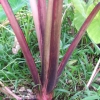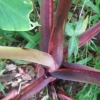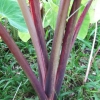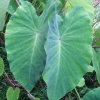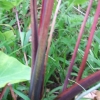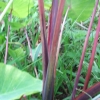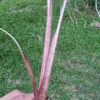Use As Food
Used as poi and table taro; the leaves are often used for lū ‘au. ‘O‘opukai is a light colored taro that has a good ‘ūlika (gumminess) factor. ‘O‘opukai pa‘i‘ai has a beige and light tan color. The color of this kalo's pa‘i‘ai can be the same hue as mango wood. According to J.K., a mature corm may turn blue when cooked.
Distribution
Planted fairly extensively in Kona, Hawai‘i, primarily under upland, dryland culture (māla), also in Hilo, but found only occasionally on the other islands.
General Characteristics
Medium in height, well spreading, maturing within 9 to 12 months, producing from 2 to 5 ‘ohā; distinguished by lilac-purple ‘i‘o kalo (Corm) flesh and reddish-purple flecked stripes.
Ha (Petiole)
65 to 90 cm. long, light yellowish-green with dark purple or reddish-purple flecked stripes and blotches, dark red at the lihi (stem edge), reddish-purple at top (apex), a dark reddish-purple ring at kōhina (base) with purplish-pink for 3 to 4 cm. above the base.
Lau or Lu'au(Leaf Blade)
50 to 65 cm. long, 35 to 45 cm. wide, 40 to 50 cm, from tip to base of sinus (māwae), egg-shaped (ovate), dark green with bluish cast; margins wave-like (undulate); piko purple; veins conspicuously reddish-purple over entire lower surface; round leaf section (lobes) acute with wide lihi māwae (sinus).
'I'o kalo (Corm)
Flesh light lilac-purple with darker purplish fibers; skin dark pinkish-lilac.
Pua (Flower)
Remarks

